

Matt Campbell
2025 Porsche 911 Carrera T review
6 Days Ago
Does the new Yaris bring enough newfound tech, safety and style to justify its formidable price hike?
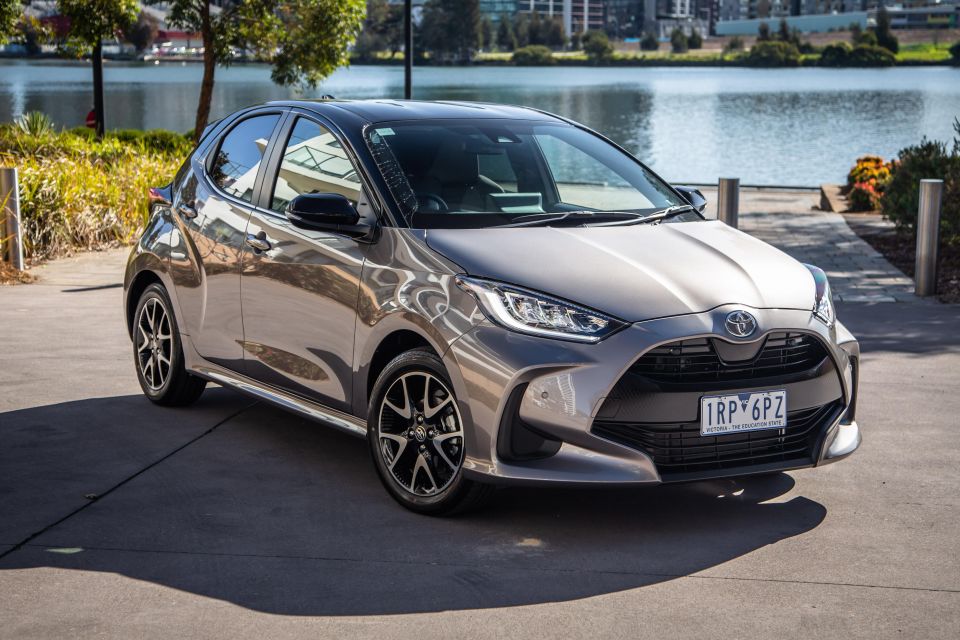


Journalist
New from
$15,390
excl. on-roads

Journalist
New from
$15,390
excl. on-roads


Journalist
New from
$15,390
excl. on-roads

Journalist
New from
$15,390
excl. on-roads
Quickly see how this car stacks up against its competition. Select any benchmark to see more details.
Where expert car reviews meet expert car buying – CarExpert gives you trusted advice, personalised service and real savings on your next new car.
Let’s cut to the chase: it looks as if the days of cheap and cheerful – and sometimes cheerless – light city cars are numbered, because costly niceties have now become necessities to buyers and legislators alike.
So while a number of carmakers continue to create low-rent compacts perhaps best suited to markets with low-rent preferences, Toyota has opted to load its diminutive Yaris with much the same tech and safety smarts as its larger ranges, such as the Corolla.
“My, look at that price,” seems the initial widespread reaction to new Yaris. Almost Corolla pricing. You have to wonder, then, how much cheaper the smaller Toyota is to build than its stablemate once you tick all of those active safety smarts, smartphone mirroring, digital display and large touchscreen ‘needs’ boxes…
Progress eh? Something’s got to give…

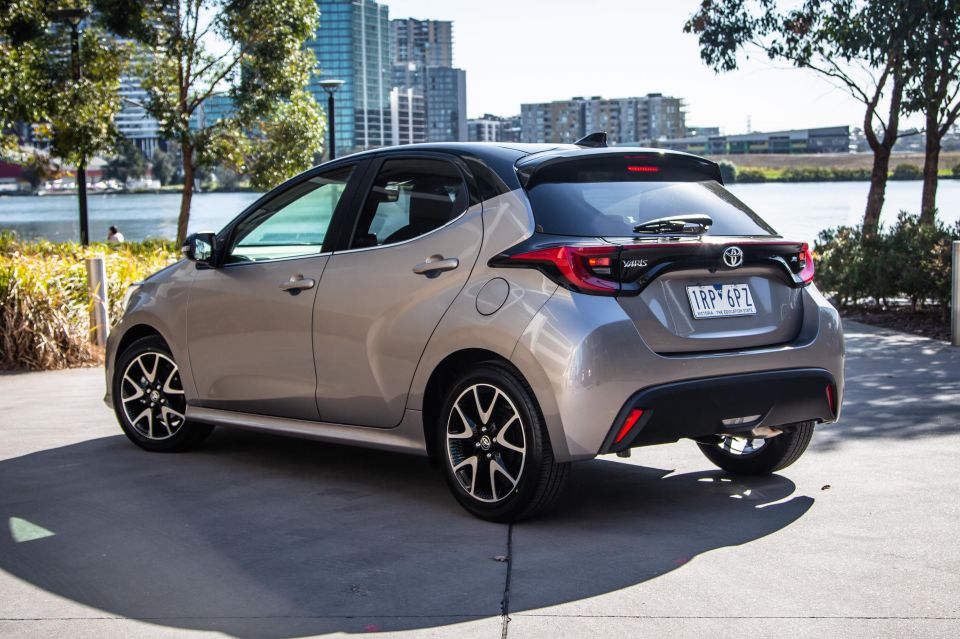
While it’s tougher than ever for carmakers to create ‘cheap good’ light cars – and even tougher for local importers to justify landing them in showrooms any more – it’s not dead craft just yet. And against other segment offerings the new Yaris looks damn pricey.
Or such is the verdict when we crunched the numbers on Yaris in spec comparison with five of its (surviving) key segment rivals. Spoiler alert: in verdict, on paper and in spec, Toyota’s newcomer in ZR petrol form is “too expensive”.
Which brings us to this road test of the same flagship version. Any Yaris starting with a three in its list price would want to be very impressive indeed in the hands-on experience, regardless of bells, whistles and window dressing…
Of the three variant grades in the Yaris range, the top-dog ZR petrol auto is priced from $30,100 before on-roads. That’s a drive-away starting point of $33,758 according to Toyota’s public website.
Adding Toyota’s popular hybrid petrol-electric powertrain adds $2000 for all the Yaris you can eat.
Want hybrid power with fewer frills? The mid-spec SX Hybrid is around a grand more affordable at $29,020 before on-roads (list). Things get juicier when you start cross-shopping its larger stablemate Corolla, which can be had for $30,795 list in SX Hybrid Hatch form or $32,695 list for ZR Hatch petrol auto.
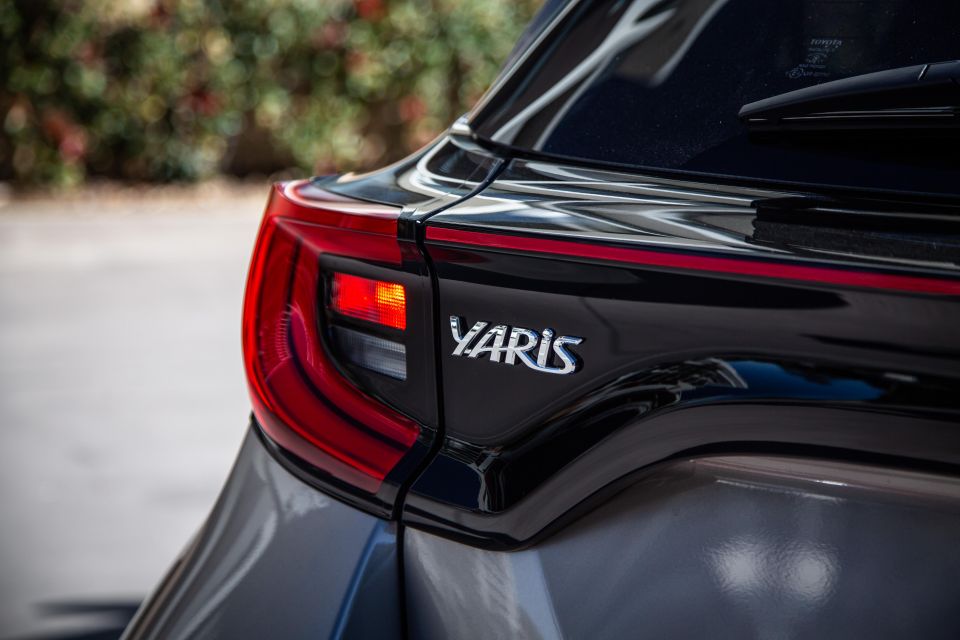

Mike Costello deep-dived into relative segment pricing in the aforementioned six-way comparison but the cheat sheet here, in order of pricing, is: Volkswagen Polo 85TSI Style at $27,490 drive-away, Mazda 2 GT at $27,485 drive-away, Kia Rio GT-Line and Suzuki Swift GLX Turbo at $23,990 drive-away apiece, and MG 3 Excite at just $18,690 drive-away. These competitors mentioned are high-graders, rather than hot or warm hatch variants.
Across all grades, Yaris comes in a choice of two standard and ten cost-optional colours, some of which can be optioned with a contrasting black or white roof at a further premium.
Our test car’s Bronx Bronze with Black roof, for example, climbs to $34,739 drive-away – around a grand premium – with its fancy and frankly fetching paintwork.
It would be remiss here not to mention styling, first and foremost. This is a far funkier and fresher looking design outside and inside than the old generation. There’s more fanfare, more texture variety and bling, which does go some way to justifying Yaris’s price rises across the board.
Outside, the ZR gets full LED lighting front and rear, power-folding mirrors, front and rear parking sensors, one-touch electric windows all round, rear privacy glass, keyless entry, 16-inch wheels, and a rear spoiler.
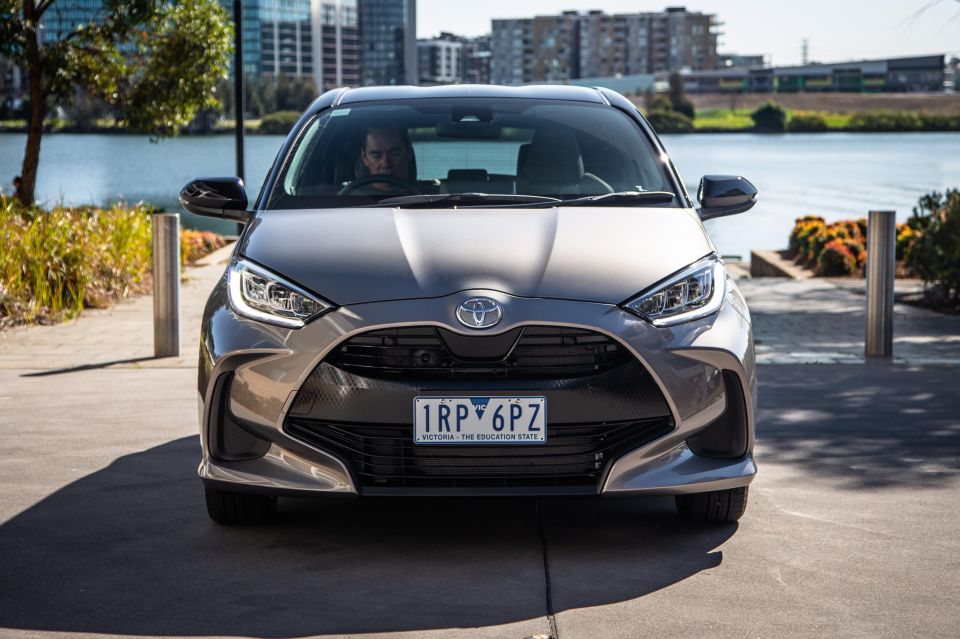
Inside, the flagship packs sports seats with a specific cloth trim, a leather-accented paddle-shifter steering wheel, head-up display, adaptive cruise control, a dual-view reversing camera, a 7.0-inch touchscreen infotainment system, DAB+, sat-nav, Apple CarPlay and Android Auto mirroring, digital-look instrumentation and speed, single-zone climate control, single USB and 12-volt ports, and a combination of red and black accents.
There’s not a lot of nice stuff left off the Yaris menu in ZR form though, equally, it doesn’t offer much in the way of exclusive gear not offered in the competitor set.
It’s a shame that leather trim, dual-zone climate control and a few more device power sources aren’t fitted at this price point.
Thus far the new Yaris hasn’t been ANCAP or Euro NCAP tested. But as an eight-airbag prospect – including front-row centre airbags – it’s brimming with active safety smarts and most certainly kicks the old five-star ANCAP-rated Yaris to the kerb.
Further, as outlined in our pricing story, its TNGA platform is common with both five-star-awarded Corolla (2018 tested) and C-HR (2017 tested) so it’s expected the new Yaris will perform well once it’s eventually put through the ANCAP assessment program.
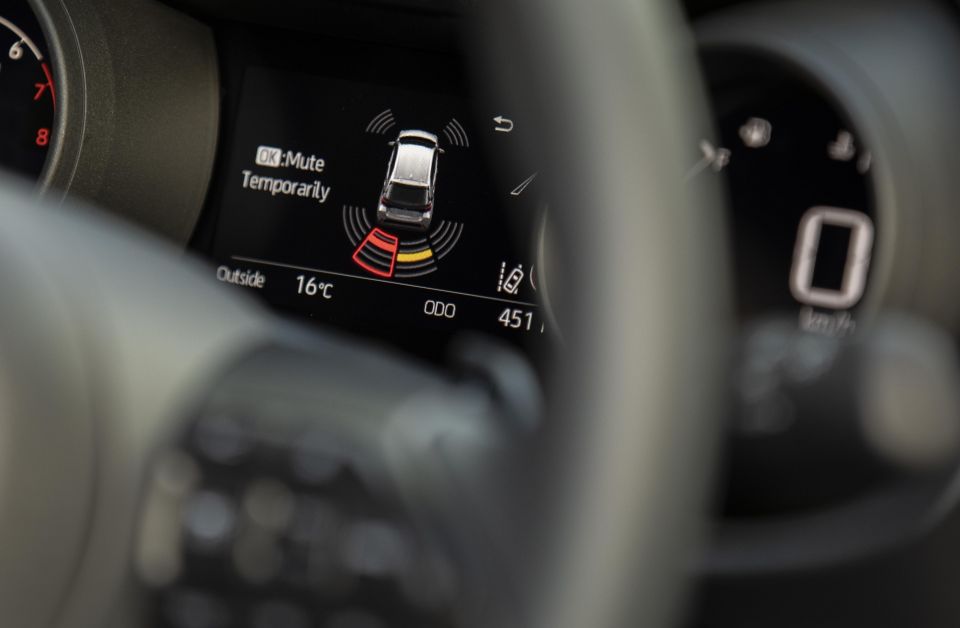
All Yaris – or is that Yari or Yarises? – get the Toyota Safety Sense suite of features that includes all-speed forward autonomous emergency braking with day and night sensing and pedestrian and (daytime only) cyclist detection, which is superior to the ‘city’-type system fitted to some competition. Lane departure warning, lane-keeping assist, high-beam assist and speed sign recognition all feature.
The ZR further bolsters Yaris safety chops with blind-spot monitoring and rear cross-traffic alert with reversing AEB. ISOFIX anchor points are located in rear outboard positions, complimented by three top tether mounts.
Does the flagship’s fulsome stack of safety gear go some way in offsetting its heady price? You bet it does.
Mirroring the interesting exterior design is a cabin that embraces some unorthodox styling features with an overtly funky theme. You’ll know within a nanosecond whether or not its vibe will fit your own personal tastes.
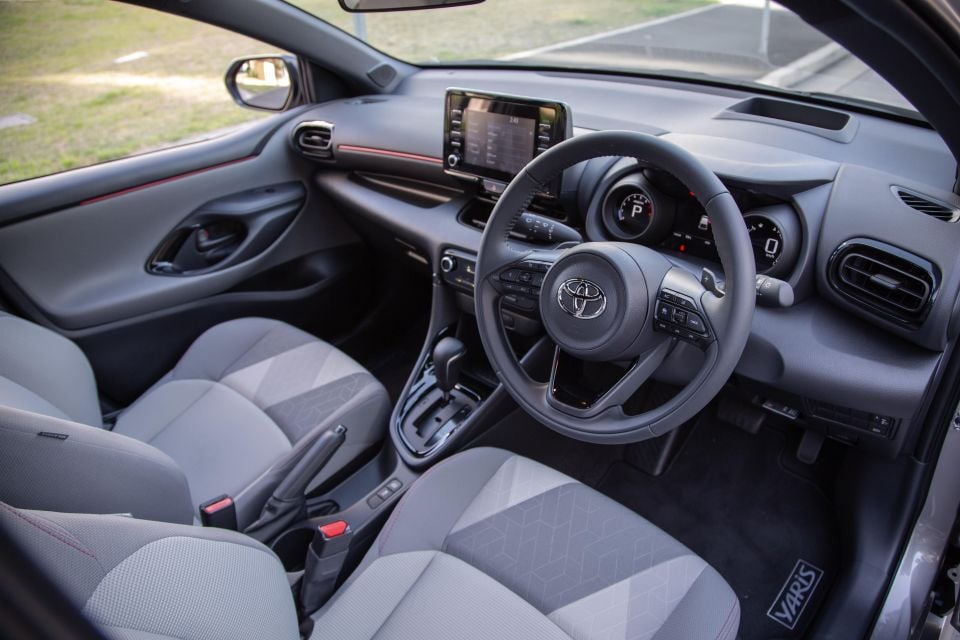
The Yaris bucks convention in a few conspicuous areas. Most obvious of the multi-level dash design, a curvaceous affair that cleverly ‘hides’ a phone tray in its middle tier, though it doesn’t inductively charge, leaving your USB cable dangling down to the sole USB port in the central stack.
It’s quite a plasticky facade, although the ZR brings a few small splashes of red and black trimming to brighten things up.
The instrumentation is quite unusual, comprised of a 4.2-inch TFT driver’s screen flanked by two, small circular digital displays, with a large colour head-up display for good measure projected into the windshield. It’s all quite logical and the large speedo display is legible at a quick glance. One quirk is that the cluster isn’t quite centred to the steering wheel – it’s slightly skewed to the left in a manner that once you notice it you can’t un-see it.
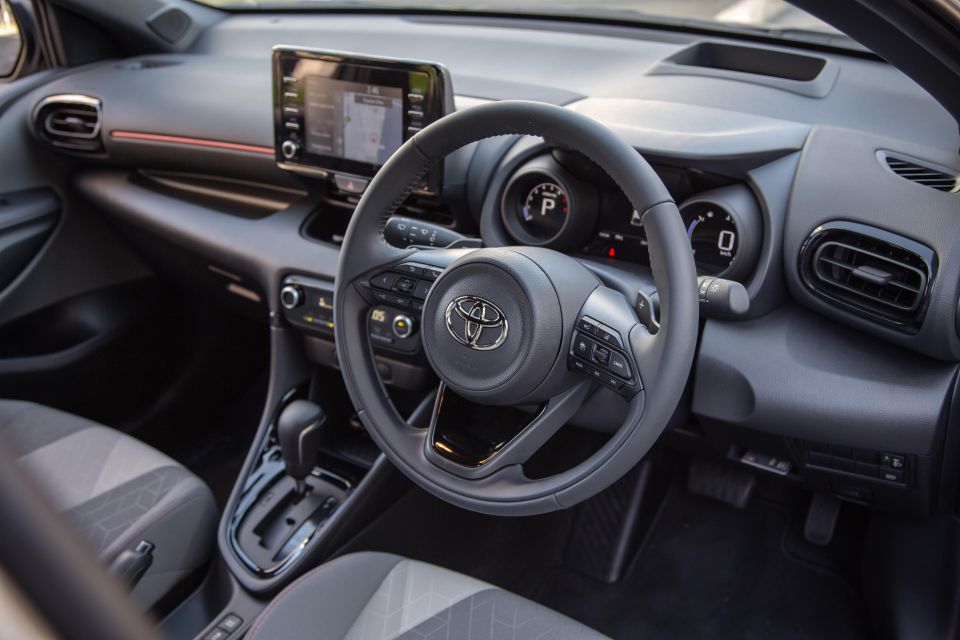

Another interesting if strange ‘feature’ is the stylised front door grab handle ‘pods’. They contrast nicely against the light grey, textured front door trim for an interesting look, but they’re a pain to use, sized for stubby fingers and awkwardly positioned too close to your body.
It’s also easy to nudge the window switches – usually dropping the rear passenger glass – with your hand when adjusting the mirror switch. Quirks? Yaris has a boatload of them. They’re mostly charming if occasionally baffling and annoying.
The large infotainment screen frame, with a thankful integration of good old buttons and volume/tuning dials, does tend to make the 7.0-inch touchscreen look a bit insignificant in stature. Its content is decent if unremarkable in design, response speed and general functionality. It does the job.
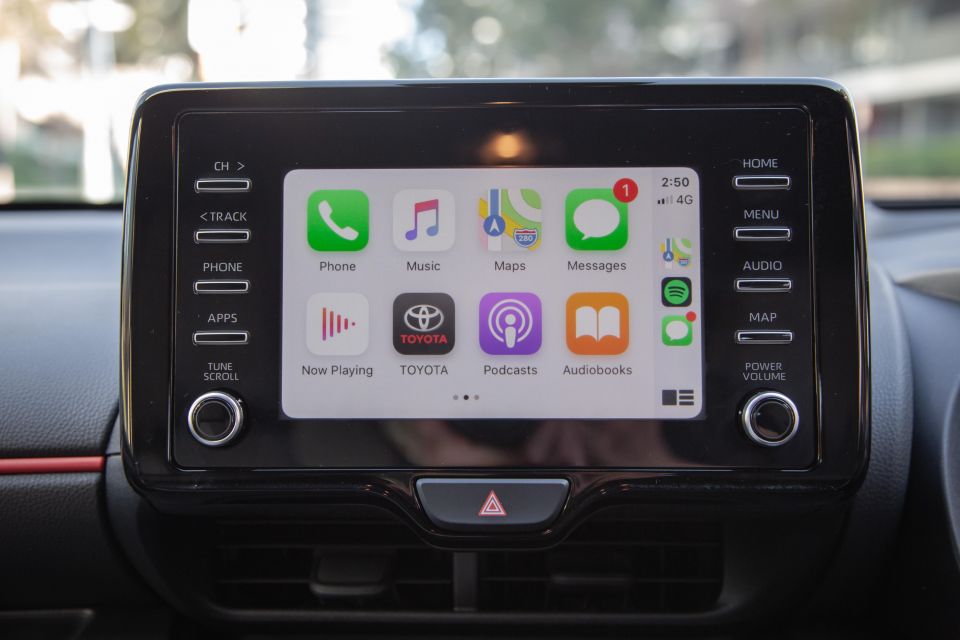
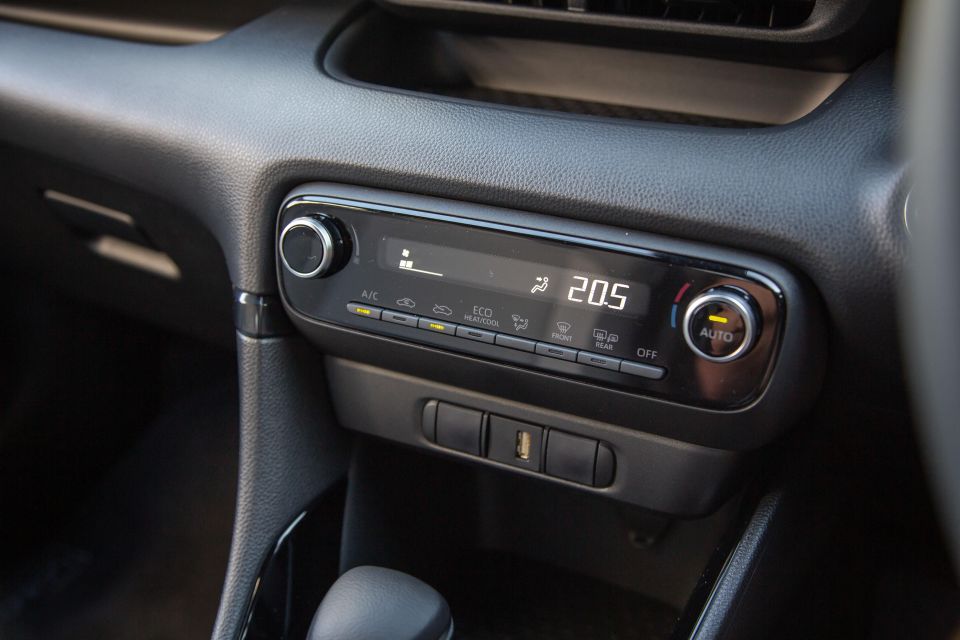
Front seating is decent, with ‘leisurely sports’ contours and a fairly hardy cloth trim in a pleasing light grey look with red stitching. Seat adjustment, like the handbrake, is mechanical. And there’s plenty of reach and height adjustment with the steering wheel that tips its hat to those found in Audis.
Something of light car trend, much of the front-row funkiness takes (ahem) a back seat in the, erm, back seat. No fabric-look textured door trim. No central armrest. No air vents. No device power.
That it’s a tight fit in every direction for adults isn’t unusual for its segment, but if rear accommodation is paramount then there are plenty of better ways to spend the kind of coin Yaris ZR asks for.
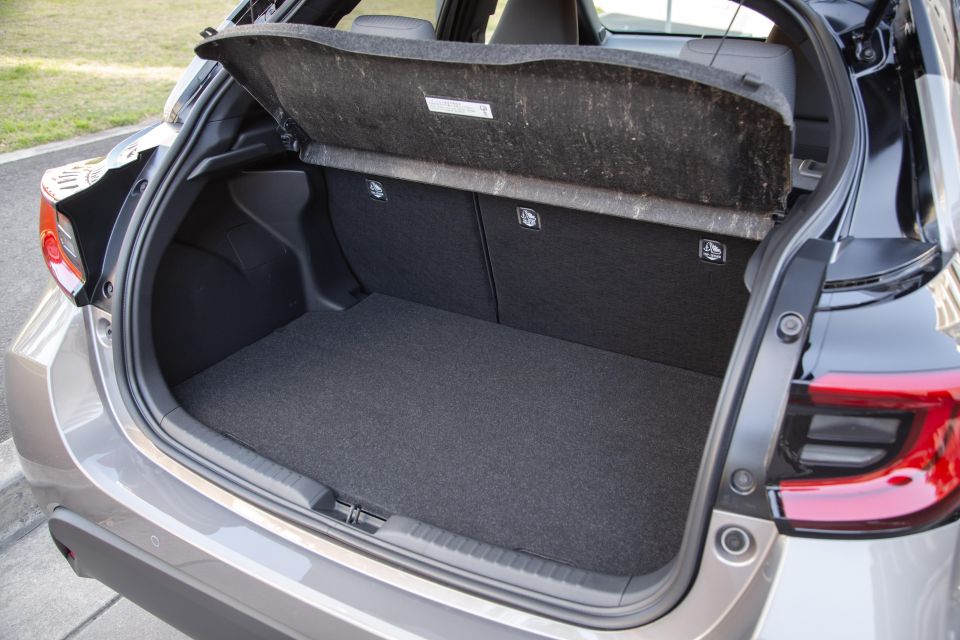
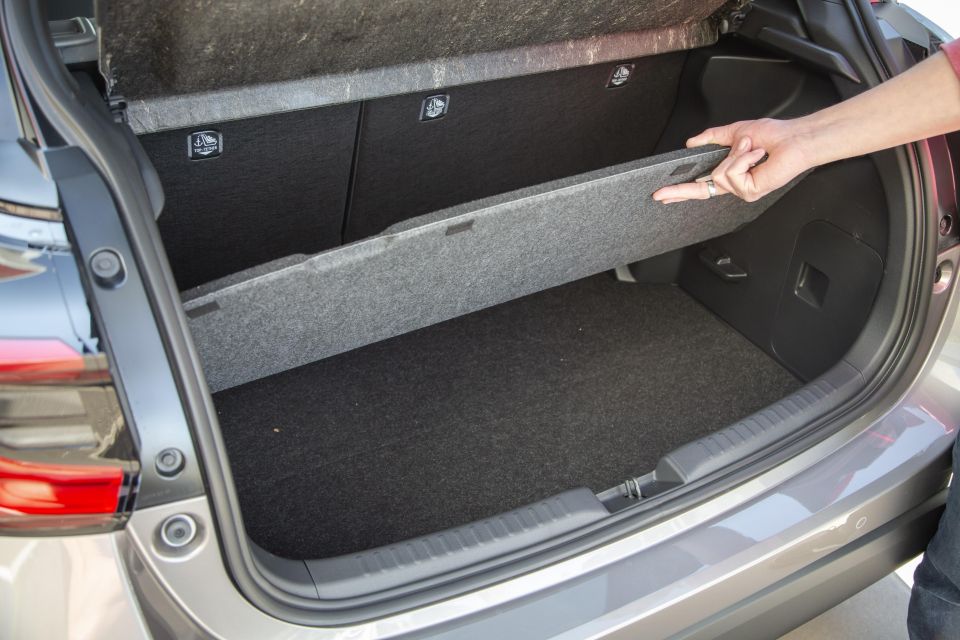
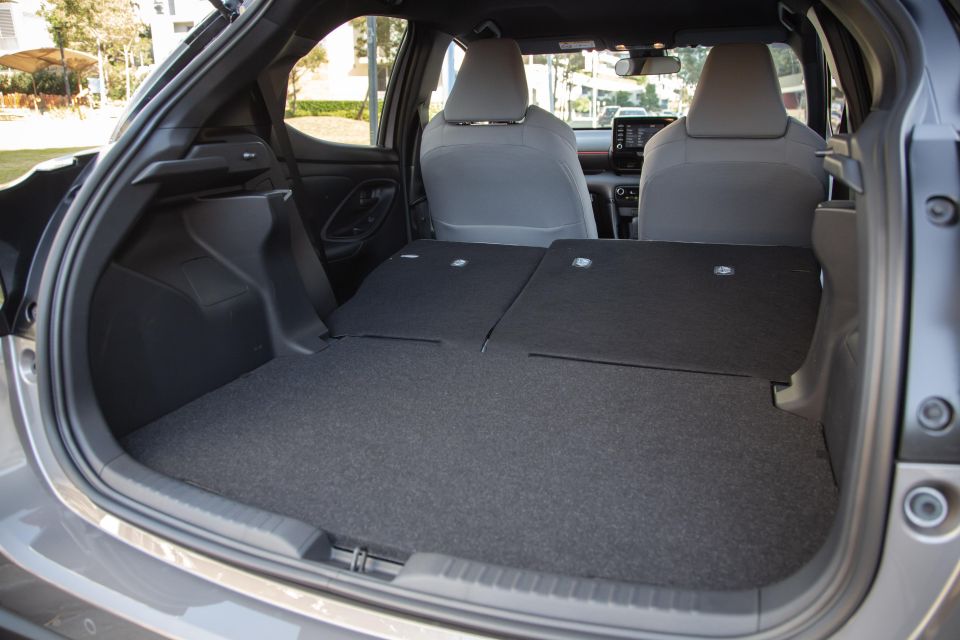
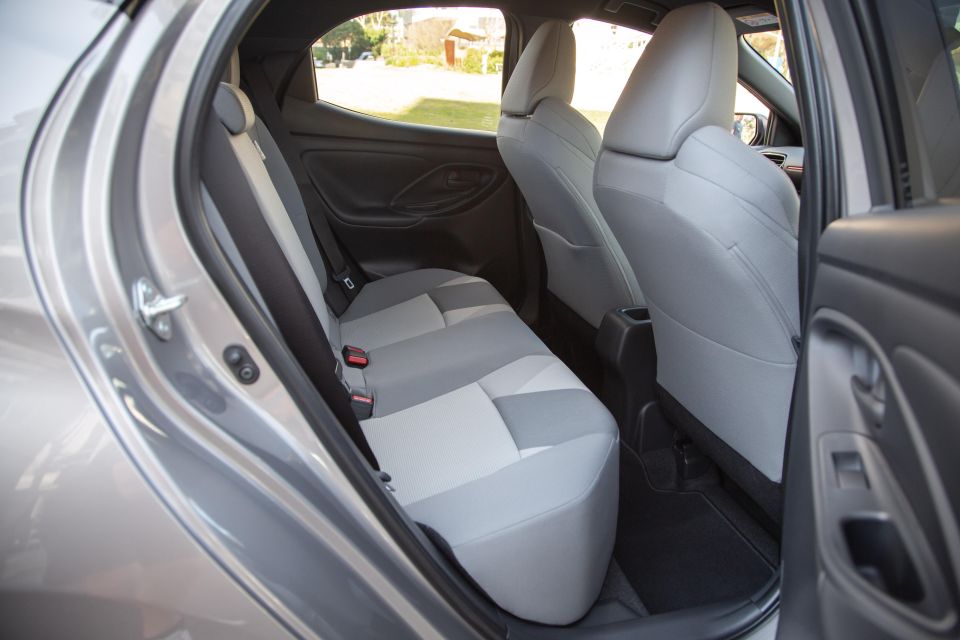
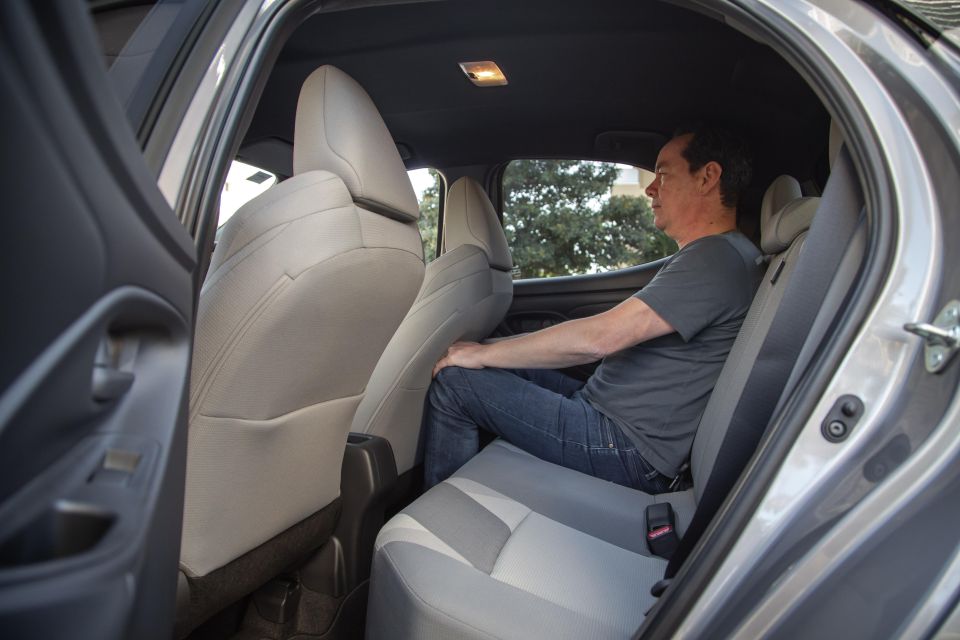
Boot space is a middling 270 litres, presumably with the removable boot floor fitted to its lowest of two positions of height: pretty handy for securing or hiding objects, whatever your need might be. The rear seat backs are 40:60 split-folding and there’s a space saver spare tucked under the boot floor(s).
The Yaris features a naturally-aspired 1.5-litre petrol three-pot in a segment where a trio of cylinders is no longer the exception. And with 88kW produced at 6600rpm it’s one of the most powerful ‘light’ contenders out there.
But due in part to the lack of thrust-enhancing turbocharging, the Yaris just doesn’t dole out much torque. It produces just 145Nm and at a point so far up in the engine’s operating range (4800rpm) that it takes a bit to dig it out.
While stats are about line-ball with the Mazda 2, many of its competitors produce more torque at a much lower engine speed, making it easier and swifter to access to boot. It’s a full 55Nm down on the class-leading Polo.
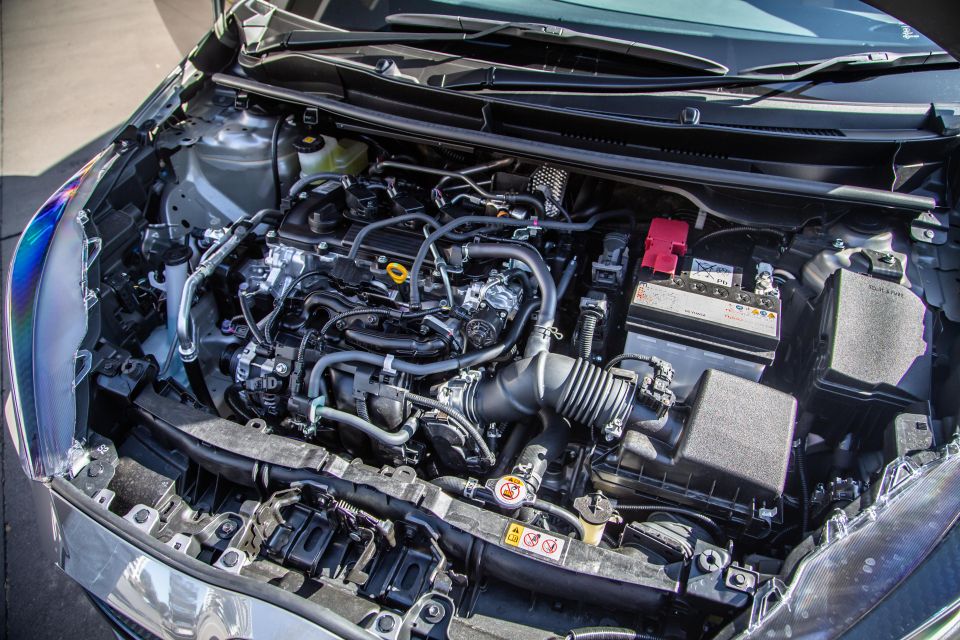
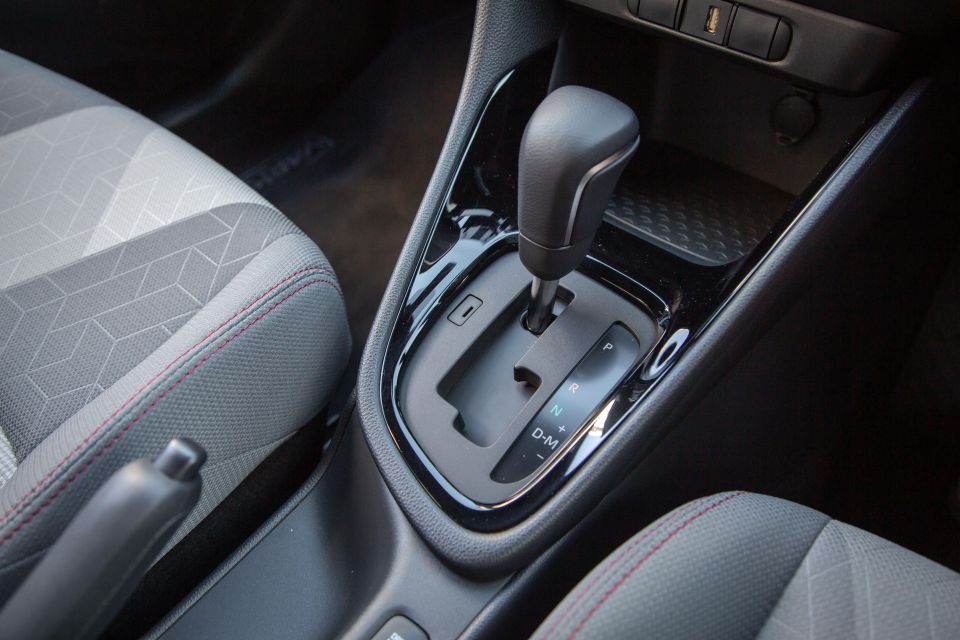
Yaris is also a bit of an outlier in that it uses a continuously variable transmission rather than the more conventional automatics favoured by much of the segment. Needless to say, there’s a bit of show business fakery when it comes to using the ZR’s wheel-mounted paddle-shifters…
The little Toyota runs happily on cheap 91RON fuel and its official 4.9L/100km combined consumption claim ranks it as the most frugal in class. At 1075kg the ZR is quite lightweight and it doesn’t demand much coaxing to sit near its combined claim, habitually hovering around the low sixes around town.
Toyota has been on top of its game with the ride and handling balance of its passenger cars. And the Yaris is no exception. The new-school TNGA is undoubtedly a fine foundation to build a quality drive upon, but it’s the nicely resolved-suspension tune that really underpins what’s a quality drive.
It offers most of what you want in a fuss-free light city car. The steering is light and direct, the ride comfort is pliant and does a polished job of rounding off poorer road imperfections, it feels engaging enough behind the wheel and it’s easy to place and judge in confined environments.
There’s nothing cheap or flimsy feeling about Yaris on the move, nor any frivolous control heaviness or ride stiffness to inject a veneer of warm hatch sportiness.
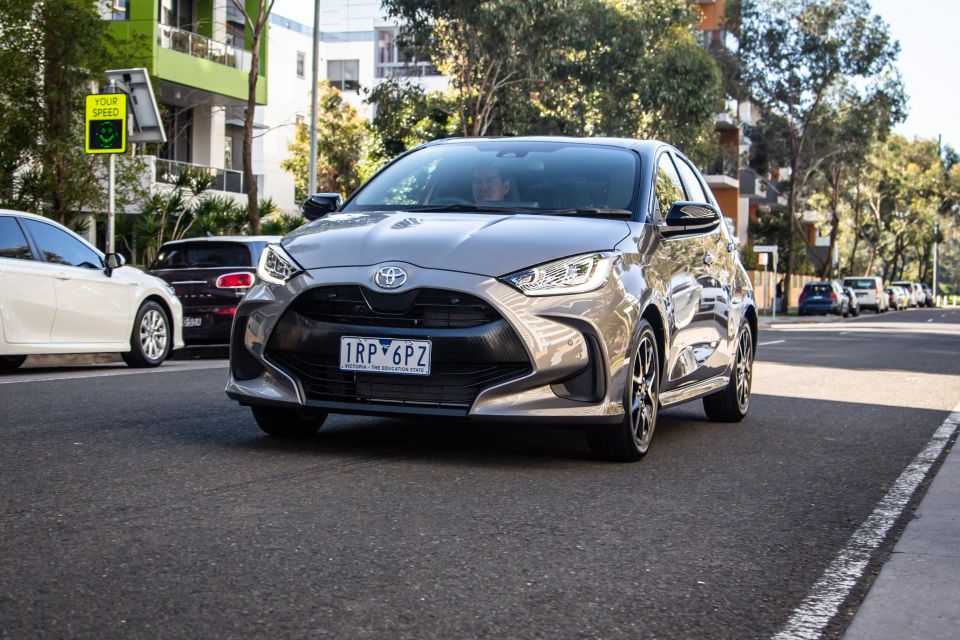
The ZR is quite the quiet operator, too, suppressing environmental and wind noise well. The only time it tends to stir up a ruckus is in tyre rumble across coarse surfaces at highway speed and pretty much any time you sink your right foot hard.
The petrol three-pot really is the only on-road lowlight, probably because the rest of it is impressively well sorted. The engine is quite responsive and fairly flexible driven one-up and in a leisurely manner, and the CVT makes a decent effort in faking forward ratios. But its decorum quickly unravels if you ask much more of it or once you start loading in passengers.
Push on and the Yaris returns a gruff, strained engine note and not a lot of interest in upping velocity with any sense of urgency. Eco mode is excessively flaccid and only skipping through Normal to Sport brings a mild sense of enthusiasm. It’s not overly tardy, but it makes such a sonic fuss about getting a move on it just seems that way.
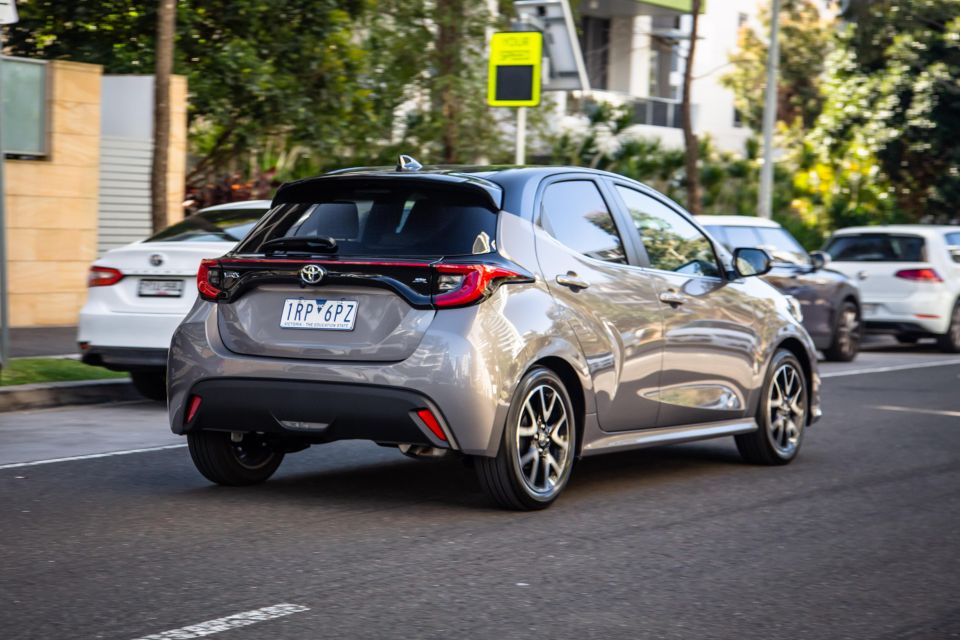
Judging by the enthusiasm one colleague has for the new hybrid version, a bit of instant electric torque assistance does wonders for Yaris’s point-and-shoot gusto and suits the light car format to a tee.
The Toyota Safety Sense tech seems general well calibrated in Yaris. The lane-keeping assist is functionally fit yet unobtrusive, there’s no hyperactivity from its proximity sensing features, and thanks to a meandering photographer I can attest to the effectiveness of the reversing AEB. You can toggle through the directional assistance – full, partial, off – with a handy wheel-mounted button.
Some stuff is less successfully executed. The audible speed camera warning is more miss than hit and – a personal bugbear – the speed sign recognition system is less than acceptably reliable. Yaris also ‘bings’ at you on shutdown with an in-dash warning to “check the rear seat” lest you forget to collect your lunch, laundry, or child.
The turning circle is a nice, concise 10.2 metres and good visibility makes swift three-point turns easy. The reversing camera’s two viewing perspectives and choice of guideline types are also pretty handy in tight spots.
The Yaris is covered by five-year, unlimited-kilometre warranty terms that can optionally be extended through to seven years.
Servicing intervals are a typical 12 months or 15,000kms, whichever comes first, with each visit capped at $195 per year for the first five years. That’s cheaper – and in the case of the Volkswagen Polo, hugely cheaper – than Yaris’s main segment rivals.
The Yaris is, at once, both a little more grown up and a bit more appealing to younger or younger-at-heart buyers. And it certainly nails the light car brief well in a good many areas where it matters in 2020: lashings of safety kit, easy and comfy to drive, impressive economy, plenty of feel-good doodads all wrapped in a compact and flamboyant package.
Less cheap, more cheerfulness. That’s progress.

But it’s really the rich price-point and lacklustre powertrain that makes the ZR petrol, specifically, a tough combination to recommend highly given the breadth of choice its near $35,000 drive-away price affords.
While not nearly as stylish, we suggest you don’t overlook the SX Hybrid version – lots of gear, a potentially nicer and more frugal drive experience – before parting with cash. Ditto any Corolla that aligns with your budget.
Where expert car reviews meet expert car buying – CarExpert gives you trusted advice, personalised service and real savings on your next new car.


Matt Campbell
6 Days Ago


James Wong
5 Days Ago


Max Davies
3 Days Ago


Josh Nevett
3 Days Ago


Josh Nevett
2 Days Ago


Paul Maric
22 Hours Ago